Section 1: Agency overview and resources
1.1 Strategic direction
The Australian Competition and Consumer Commission (ACCC) is an independent statutory authority which administers the Competition and Consumer Act 2010 (CCA) and performs functions under other Commonwealth legislation and State and Territory competition policy reform Acts.
The Australian Energy Regulator (AER), which is part of the ACCC, regulates the national energy market.
The ACCC's outcome is: lawful competition, consumer protection, and regulation of national infrastructure markets and services, including enforcement, education, price monitoring and determining the terms of access to infrastructure services.
The AER will have significant new functions under the National Energy Consumer Framework (NECF) in regulating energy retail and distribution businesses. The AER will continue to work within the evolving regulatory landscape while performing regulatory resets, monitoring compliance and providing timely and relevant information to energy market participants.
A further significant measure for the ACCC is the implementation and enforcement of the new consumer protection and fair trading provisions of the second tranche of the Australian Consumer Law (ACL). The ACL rationalises consumer laws and enhances the protection of consumers. This supports the implementation of one of the 27 deregulation priorities under the Council of Australian Governments' National Partnership to Deliver a Seamless National Economy. In conjunction with the ACL implementation, the ACCC will also be undertaking an awareness-raising campaign to educate consumers and businesses about their rights and obligations under the new consumer guarantees laws.
The ACCC will also be undertaking additional activities as a result of the Government's final response to the recommendations of the National Broadband Network (NBN) Implementation Study.
In performing its role, the ACCC is alert to market conduct that may impact adversely on competition and consumers. Specific areas for the ACCC's attention are mergers, unconscionable conduct, franchising opportunities, misleading and deceptive conduct, harassment and coercion, and cartel conduct. The ACCC's regulatory role will continue to reflect the view that competition provides the best incentive for firms and institutions to become more efficient, innovative and flexible.
1.2 Agency resource statement
Table 1.1 shows the total resources from all origins. The table summarises how resources will be applied by outcome and by departmental classification.
Table 1.1: Australian Competition and Consumer Commission resource statement — Budget
estimates for 2011-12 as at Budget May 2011
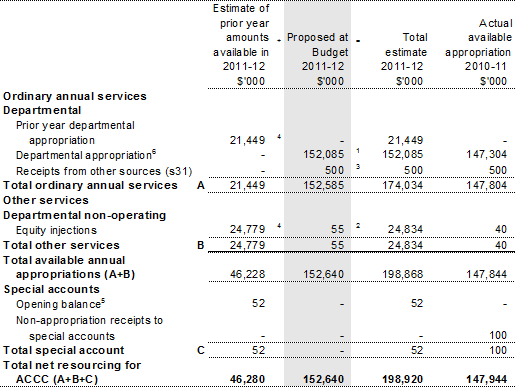
1. Appropriation Bill (No. 1) 2011-12.
2. Appropriation Bill (No. 2) 2011-12.
3. Receipts received under section 31 of the Financial Management and Accountability Act 1997.
4. Estimated adjusted balance carried from previous year for annual appropriations.
5. Estimated opening balance for special accounts (refer to Table 3.1.2 for further details).
6. Includes $2.5 million in 2011-12 for the departmental capital budget (refer to Table 3.2.5 for further details).
Third party payments from and on behalf of other agencies

Note: The ACCC provides financial services to the NCC and has drawdown access to manage the NCC's finances.
1.3 Budget measures
Budget measures relating to ACCC are detailed in Budget Paper No. 2, Budget Measures 2011-12 and are summarised below.
Table 1.2: Australian Competition and Consumer Commission 2011-12 Budget measures
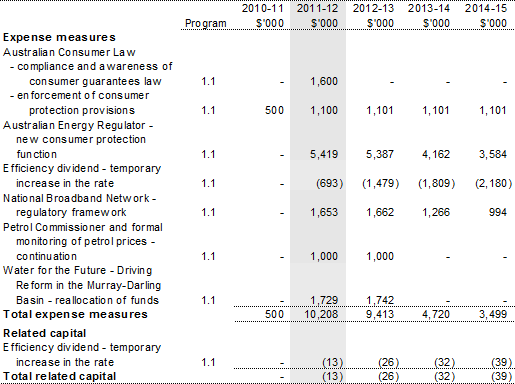
Prepared on a government finance statistics (fiscal) basis.
Section 2: Outcomes and planned performance
2.1 Outcomes and performance information
Government outcomes are the intended results, impacts or consequences of actions by the Government on the Australian community. Commonwealth programs are the primary vehicle by which government agencies achieve the intended results of their outcome statements. Agencies are required to identify the programs which contribute to Government outcomes over the budget and forward years.
The ACCC's outcome is described below, specifying the strategy, program, objective, deliverables and key performance indicators used to assess and monitor the performance of the ACCC.
Outcome 1: Lawful competition, consumer protection, and regulated national infrastructure markets and services through regulation, including enforcement, education, price monitoring and determining the terms of access to infrastructure services
Outcome 1 strategy
To achieve its outcome the three strategies the ACCC will pursue are:
- promote vigorous, lawful competition and informed markets;
- encourage fair trading, protection of consumers and product safety; and
- regulate national infrastructure services (such as communications, bulk water, energy, rail, airports, post and wheat exports) and other markets where there is limited competition.
The intended results and target groups of the ACCC program are:
- detect, pursue and stop anti-competitive conduct — including cartels — and misuse of market power;
- promptly deliver authorisation and notification decisions, particularly on small business collective bargaining arrangements;
- assess mergers promptly and efficiently across all industries, taking effective action to address substantial competition concerns arising from mergers;
- identify and focus effectively on national and cross-border (including international) consumer protection issues;
- pursue and achieve appropriate remedies for false and deceptive conduct, particularly conduct resulting in widespread detriment;
- ensure that trading conditions between big and small firms are fair;
- promote product safety through identification and regulation of emerging hazards, active engagement in recalls, and enforcement of standards and bans;
- support and protect competition in markets that rely on networks with natural monopoly characteristics;
- provide consistent and independent regulation of the energy sector, encouraging competition within and between the gas and electricity markets to benefit industry and consumers;
- regulate and advise on industries where market structures are changing, including where the market structure impedes effective competition (for example water, transport and communications); and
- monitor prices to assess and advise on the effect of market conditions (including deregulation) on the price levels of specified goods and services, including petrol and a range of airport prices including car parking.
Outcome expense statement
Table 2.1 provides an overview of the total expenses for Outcome 1.
Table 2.1: Budgeted expenses for Outcome 1
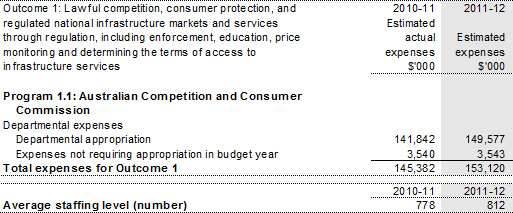
Contributions to Outcome 1
Program 1.1: Australian Competition and Consumer Commission
Program objectives
The ACCC program objective is to
administer the CCA, and associated legislation, to bring greater competitiveness, fair trading, consumer protection and product safety to the Australian economy, working on the fundamental principle that this benefits consumers, business and the wider community.
The ACCC promotes compliance with federal competition, fair trading, consumer protection and product safety laws.
The ACCC and AER regulate markets where competition is less effective — for example communications (ACCC), transport (ACCC) and energy markets (AER and ACCC).
Program expenses
There are no significant changes to estimates across the forward years.
Table 2.2: Program expenses

Program deliverables
To promote compliance with federal competition, fair trading, consumer protection and product safety laws, the ACCC has the following program deliverables:
- effective and appropriate actions (investigations, litigation, communication) are taken to prevent and stop;
- anti-competitive conduct;
- misleading, deceptive and unconscionable conduct, especially conduct that causes widespread consumer detriment; and
- non-compliance with mandatory codes of conduct.
- effective and appropriate actions are taken to promote product safety, including responding to emerging hazards, managing product recalls, and enforcing standards and bans;
- support is provided to increase the ability of small business to trade with larger firms in a fair, yet competitive environment;
- immediate information is provided to thousands of callers each week; publications are widely distributed through print and the web; and special information programs reach small, isolated or disadvantaged groups; and
- effective and appropriate education campaigns are conducted that target industries and sectors where the risk of failure to comply with the CCA is high.
To regulate markets where competition is less effective — for example communications (ACCC), transport (ACCC) and energy markets (AER and ACCC) — the ACCC and AER have the following program deliverables:
- access terms, conditions and prices balance the interests of infrastructure owners and users and the broader public;
- incentives are provided that stimulate efficient investment in and use of services with natural monopoly characteristics;
- regulatory processes that support efficient resource allocation, including investment in the regulated businesses, are predictable and consistent;
- prices of specified goods and services are monitored to assess the effect of market conditions on price levels, and the government and public are advised accordingly; and
- all the outcomes of access arbitrations, arrangements and undertakings, monitoring activities and inquiry findings are publicised.
Program key performance indicators
From promoting vigorous, lawful competition and informed markets (CCA Parts IV, VII, XIA) and encouraging fair trading, protection of consumers and product safety (CCA Schedule 2, Part IVB, Trade Marks Act 1995 and Copyright Act 1968), the ACCC has the following key performance indicators:
- meet with key consumer and business groups every six months;
- 70 per cent of phone calls answered within 20 seconds;
- 95 per cent of emails responded to within seven days;
- 95 per cent of letters responded to within 28 days;
- make decisions within seven days of receipt about whether to refer written complaints to an investigative unit;
- 80 per cent of under assessment matters concluded or progressed to initial investigations within 28 days;
- 80 per cent of initial investigations concluded or progressed to in-depth investigations within 90 days;
- 80 per cent of in-depth investigations concluded or progressed to litigation within one year;
- obtain positive outcomes from an expected 25 court cases and an expected 40 court enforceable undertakings;
- resolve expected 50 enforcement actions to prevent or stop conduct causing detriment to consumers or small business;
- monitor media and industry on a daily basis for possible Mergers and Acquisition reviews;
- actions against unlawful conduct;
- effective and appropriate remedies for unlawful conduct;
- outcomes from an expected 20 court cases (for competition, fair trading and consumer protection);
- outcomes from an expected 40 court enforceable undertakings (predominately for consumer protection conduct that has breached or is likely to breach the CCA);
- assessment of mergers within statutory and organisational timelines and in accordance with published guidelines;
- publication on accc.gov.au of all public merger decisions;
- authorisation and notification decisions within statutory and organisational timeframes (assessment of validity within five days, authorisation within six months, majority of notifications within four weeks) and promptly communicated;
- collective bargaining notification decisions within statutory timeframes (assessment of validity within five days, initial assessment within 14 days) and communicated promptly;
- publicity, liaison and education activities that are timely and reach the target audiences — 750,000 publications and 250 media releases;
- enforcement of mandatory codes of conduct;
- assistance to parliamentary inquiries and government agencies to develop policies and processes; and
- websites (www.accc.gov.au, www.recalls.gov.au, www.productsafety.gov.au and www.scamwatch.gov.au) that are accessible and a source of relevant and up-to-date information.
From regulating national infrastructure services and other markets where there is limited competition (CCA Parts IIIA, VIIA, X, XIB, XIC; National Gas Law 2008, National Gas Rules, National Electricity Law 2005; National Electricity Rules; Airports Act 1996; Broadcasting Services Act 1992; Radiocommunications Act 1992; Telecommunications Act 1997; Telecommunications (Consumer Protection and Service Standards) Act 1999; Water Act 2007; Wheat Export Marketing Act 2008), the ACCC has the following key performance indicators:
- provide annual monitoring report to the Minister for Sustainability, Environment, Water, Populations and Culture on rule compliance (annually in March);
- complete Petrol Monitoring Report in order to provide to the Minister on an annual basis;
- prepare all guidelines, instruments and the comparator website for the National Energy Customer Framework prior to 30 June 2012;
- consult with Government, industry and consumer groups in preparation for Customer Framework, including by holding three Customer Consultative Group meetings;
- publish weekly electricity and gas reports and wholesale market high-price event reports in accordance with statutory timelines; publish State of the Energy Market Report;
- finalise two gas access arrangement decisions, two electricity revenue determinations and AMI budget approvals for the Victorian DNSPs;
- develop and implement new information requirements and a new connections framework for network businesses;
- complete annual tariff processes for network businesses;
- publish Regulator Observer report on the website on a 2-3 week basis;
- publish guidance for stakeholders in relation to Part IIIA of the TPA by targeted function on an annual basis;
- provide responses to ministerials within 14 days and public correspondence within 28 days;
- provide Container Stevedoring Monitoring Report to Treasurer on an annual basis (October);
- publish Price Monitoring and Quality of Service Report for the five major airports on an annual basis (Ma
rch); - complete access undertakings within statutory timeframes;
- complete price notifications within statutory timeframes;
- complete arbitration determinations within statutory timeframes;
- publish Accounting Separation-Imputation Report and Non-Price KPI Report on a quarterly basis;
- publish Competition and Consumer Safeguards Report (Division 11 and 12 Report) on an annual basis;
- provide Retail Price Control Report on an annual basis to the Minister;
- publish Accounting Separation-Current Cost Accounting Report on a bi-annual basis;
- compliance with statutory reporting requirements to the Minister for Broadband, Communications and the Digital Economy;
- implementation of reasonable terms and conditions of access in arbitral determinations under the telecommunications access regime;
- review of declarations of declared services under the telecommunications access regime within statutory timeframes;
- assistance to the Australian Competition Tribunal and Courts in review of any appealed ACCC regulatory decisions under the telecommunications access regime;
- assistance to parliamentary inquiries and government agencies to develop policies and processes;
- effective access regimes (evidenced by price levels and service delivery standards);
- improvement (to more closely reflect efficient costs) in prices paid by businesses using monopoly services;
- timely and accessible regulatory reports, determinations, and issues papers;
- robust and accurate regulatory methodology (evidenced by industry acceptance); and
- websites (www.accc.gov.au and www.aer.gov.au) that are accessible and a source of relevant and up-to-date information.
Section 3: Explanatory tables and budgeted financial statements
Section 3 presents explanatory tables and budgeted financial statements which provide a comprehensive snapshot of agency finances for the 2011-12 budget year. It explains how budget plans are incorporated into the financial statements and provides further details of the reconciliation between appropriations and program expenses, movements in administered funds, special accounts and government Indigenous expenditure.
3.1 Explanatory tables
3.1.1 Movement of administered funds between years
The ACCC does not have any administered funds.
3.1.2 Special accounts
Special accounts provide a means to set aside and record amounts used for specified purposes. Special accounts can be created by a Finance Minister's Determination under the Financial Management and Accountability Act 1997 (FMA Act) or under separate enabling legislation. Table 3.1.2 shows the expected additions (receipts) and reductions (payments) for each account used by the ACCC.
Special public moneys are held by the ACCC in a trustee capacity. The trust moneys are a result of court orders of which payments to the beneficiaries are pending. These moneys are temporarily held for the benefit of a person or entity other than the Australian Government. This special account is departmental in nature and is governed by section 20 of the FMA Act.
Table 3.1.2: Estimates of special account cash flows and balances

3.1.3 Australian Government Indigenous expenditure
The ACCC does not have any Australian Government Indigenous expenditure.
3.2 Budgeted financial statements
The budgeted financial statements contain estimates prepared in accordance with the requirements of the government's financial budgeting and reporting framework, as well as specific guidelines issued by the Department of Finance and Deregulation. The statements show the planned financial performance for the 2011-12 budget year and estimated actual for 2010-11 for comparative purposes.
3.2.1 Differences in agency resourcing and financial statements
There are no differences between agency resourcing and financial statements.
3.2.2 Analysis of budgeted financial statements
An analysis of the ACCC's budgeted financial statements as reflected in the budgeted departmental financial statements and administered schedules for 2011-12 is provided below.
Departmental
Comprehensive income statement
The ACCC is budgeting for a break even result for 2011-12 and for the remainder of the forward estimates. This break even result will occur after adding back non-appropriated depreciation and amortisation expenses under the new net cash appropriation arrangements, which began in the 2010-11 Budget.
Operating revenues
Total appropriation revenue for 2011-12 is estimated to be $152.1 million. This figure includes $2.6m for Departmental Capital Budget funding under the new appropriation framework arrangements.
Operating expenses
Total expenses in 2011-12 are estimated to be $153.1 million. This is an increase of $7.7m from the 2010-11 estimated actual. This increase is primarily attributable to the new measures the ACCC will be undertaking in 2011-12.
Balance sheet
The ACCC's budgeted net asset position of $43.2 million represents a decrease of $0.9 million from the 2010-11 estimated actual. This is the difference between the ACCC depreciation charge and the departmental capital budget funding.
The total assets are expected to be $77.5 million, a decrease of $0.9 million from 2010-11 primarily as a result of a decrease in value of land and buildings.
The ACCC's primary liability continues to be accrued employee leave entitlements of $21.5 million.
3.2.3 Budgeted financial statements tables
Table 3.2.1: Budgeted departmental comprehensive income statement
(for the period ended 30 June)
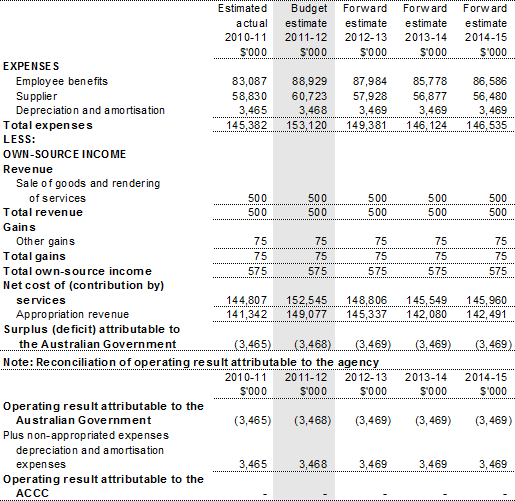
Prepared on Australian Accounting Standards basis.
Table 3.2.2: Budgeted departmental balance sheet
(as at 30 June)

Prepared on Australian Accounting Standards basis.
Table 3.2.3: Budgeted departmental statement of cash flows
(for the period ended 30 June)
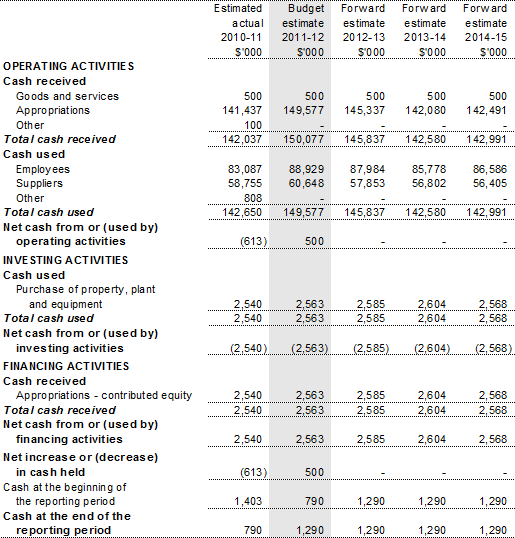
Prepared on Australian Accounting Standards basis.
Table 3.2.4: Departmental statement of changes in equity — summary of
movement (budget year 2011-12)
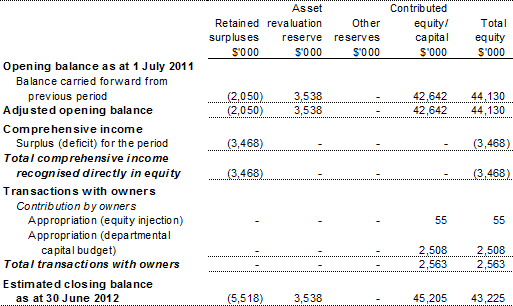
Prepared on Australian Accounting Standards basis.
Table 3.2.5: Departmental capital budget (DCB) statement
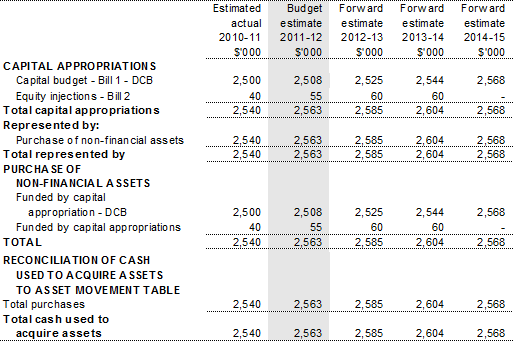
Prepared on Australian Accounting Standards basis.
Table 3.2.6: Statement of asset movements — departmental
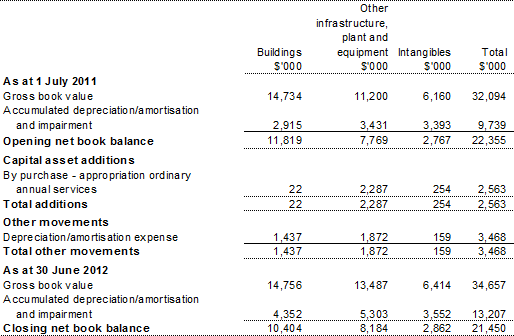
Prepared on Australian Accounting Standards basis.
Table 3.2.7: Schedule of budgeted income and expenses administered on behalf of
Government (for the period ended 30 June)

Prepared on Australian Accounting Standards basis.
Table 3.2.8: Schedule of budgeted assets and liabilities administered on behalf of
Government (as at 30 June)
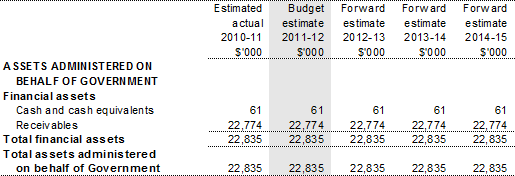
Prepared on Australian Accounting Standards basis.
Table 3.2.9: Schedule of budgeted administered cash flows
(for the period ended 30 June)
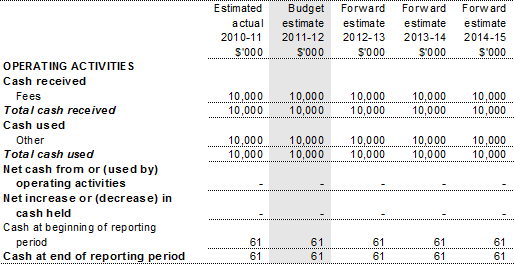
Prepared on Australian Accounting Standards basis.
3.2.4 Notes to the financial statements
Accounting policy
The budgeted financial statements have been prepared on an accrual accounting basis having regard to statements of accounting concepts, and in accordance with:
- the Government's financial budgeting and reporting framework; and
- Australian Accounting Standards and Interpretations issued by the Australian Accounting Standards Board.
Departmental and administered items
Departmental assets, liabilities, revenues and expenses are those items that are controlled by the ACCC that are used by the ACCC in producing its program and include:
- computers, plant and equipment and building fitout used in providing goods and services;
- liabilities for employee entitlements;
- revenue from appropriations or independent sources in payment for the departmental program; and
- employee, supplier and depreciation expenses incurred in providing the departmental program.
Administered items are those items incurred in providing programs that are controlled by the Government and managed, or oversighted by the ACCC on behalf of the government. Administered revenues include fees and fines.
Departmental revenue
Revenue from government represents the purchase of outputs from the ACCC by the Government and is recognised to the extent that it has been received into the ACCC's bank account.
Revenue from other sources, representing sales from goods and services, is recognised at the time that it is imposed on customers.
Departmental expenses — employees
Payments and net increases in entitlements to employees for services rendered in the financial year.
Departmental expenses — suppliers
Payments to suppliers for goods and services used in providing agency programs.
Departmental expenses — depreciation and amortisation
Depreciable property, plant and equipment, buildings and intangible assets are written-off to their estimated residual values over their estimated useful life, using the straight-line calculation method.
Departmental assets — financial assets
The primary financial asset relates to receivables. Financial assets are used to fund the ACCC's capital program, employee entitlements, creditors and to provide working capital.
Departmental assets — non-financial assets
These items represent future benefits that the ACCC will consume in producing outputs. The reported value represents the purchase paid less depreciation incurred to date in using the asset.
Departmental liabilities — provisions and payables
Provision has been made for the ACCC's liability for employee entitlements arising from services rendered by employees. The liability includes unpaid annual leave and long service leave.
Provision has also been made for unpaid expenses as at balance date.